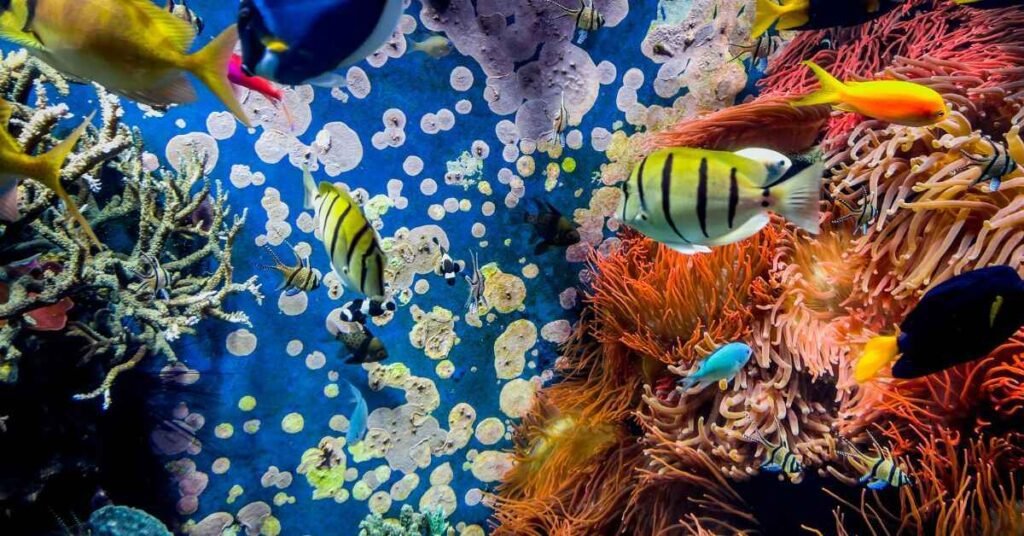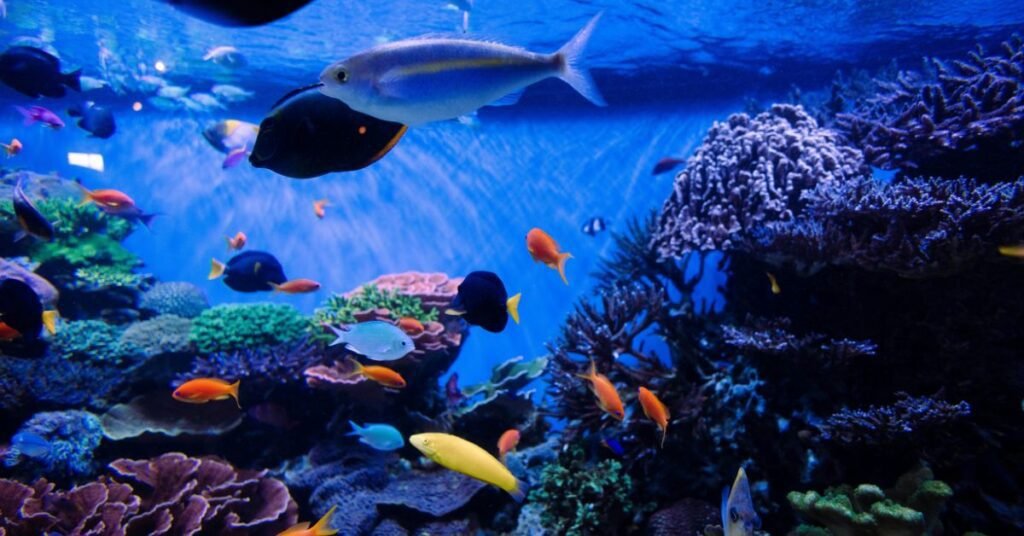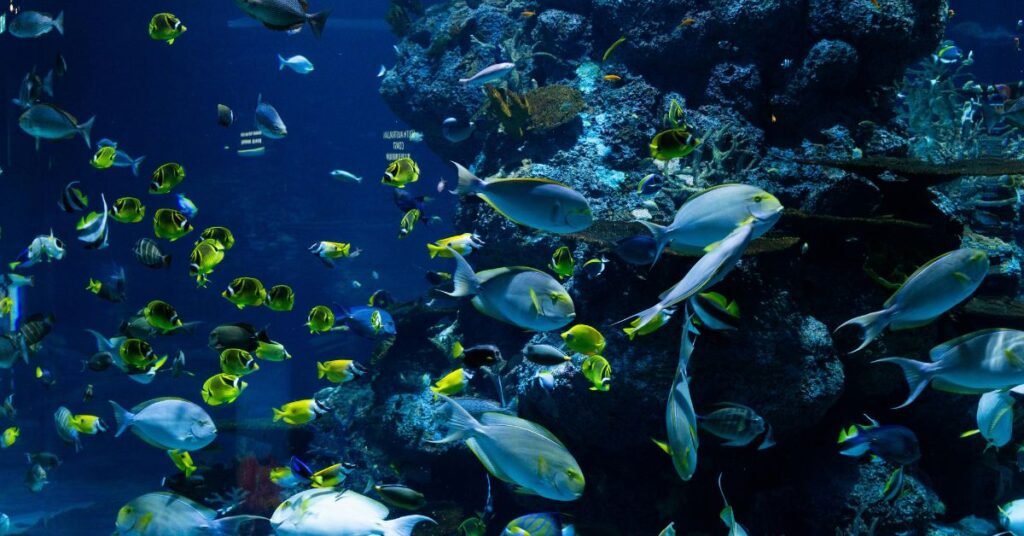Setting up a saltwater aquarium is an exciting hobby that requires some knowledge and preparation. A saltwater aquarium is a beautiful addition to any home, with colorful fish and other marine life. To set up a saltwater aquarium, you’ll need some basic equipment and an understanding of the process. First, you’ll need to choose the right tank and stand for your space. Next, you’ll need to select the right equipment, like a protein skimmer and heater. Then, you’ll need to set up your tank and add water and salt. After that, you’ll need to cycle your tank to make it safe for fish. Once your tank is ready, you can add fish and other marine life. With proper care and maintenance, your saltwater aquarium will be happy and healthy.
Step 1: Plan Your Aquarium
Determine the size and type of aquarium you want to set up. Research the equipment and livestock you’ll need, and consider the space and lighting available for your aquarium. Plan the layout and design of your aquarium, taking into account the needs of the fish and other livestock you want to keep.
Step 2: Choose Your Equipment
Select a high-quality aquarium tank and stand, a suitable protein skimmer, heater, and filter, a hydrometer or refractometer to measure salinity, and a fish net and algae scraper for maintenance. Research and select a high-quality salt mix that is designed for aquarium use.

Step 3: Set Up Your Tank and Stand
Assemble the stand according to the manufacturer’s instructions. Place the tank on the stand, ensuring it’s level and even. Check the tank for levelness and adjust the stand if necessary. Ensure the tank is securely attached to the stand to prevent accidental tipping or leakage.
Step 4: Add Substrate and Decorations
Choose a suitable substrate (sand or gravel) and add it to the tank, rinsing it in a bucket before adding it to the tank. Add decorations, such as live rock or artificial decorations, to create hiding places and visual interest. Arrange the decorations to create a natural-looking environment that provides hiding places and visual interest for your fish.
Step 5: Install Equipment
Install the protein skimmer, heater, and filter according to the manufacturer’s instructions. Connect the equipment and test it to ensure proper function. Securely attach equipment to the tank or stand to prevent damage or leakage.
Step 6: Mix and Add Saltwater
Mix salt water according to the manufacturer’s instructions. Add the saltwater to the tank, slowly and carefully. Monitor the tank’s salinity and adjust as necessary to maintain the proper salinity levels for your fish and other livestock.
Step 7: Cycle Your Tank
Allow the tank to cycle for 2-4 weeks before adding fish. Monitor the tank’s water parameters and make adjustments as necessary. Add beneficial bacteria to the tank to aid in the cycling process, which will help to establish a healthy biological balance in your tank.
Step 8: Add Fish and Other Livestock
Choose fish and other livestock suitable for your tank’s size and water parameters. Acclimate them to the tank’s water parameters before adding them to the tank. Monitor their health and well-being, making adjustments as necessary to ensure their health and happiness.
Step 9: Maintain Your Tank
Regularly test water parameters and make adjustments as necessary. Change the water frequently and clean the tank if necessary. Monitor the health and well-being of your fish and other livestock. Enjoy your thriving saltwater aquarium, and happy aquarium keeping.

The Importance of Water Quality in Saltwater Aquariums
Setting up a saltwater aquarium is way more important, as it directly affects the health and well-being of marine life. Poor water quality can lead to stress, disease, and even death in fish and other aquarium inhabitants. Here are some key aspects of water quality to monitor and maintain in a saltwater aquarium:
- Salinity: Maintain a stable salinity level between 1.020 and 1.025.
- pH: Keep the pH level between 8.1 and 8.3.
- Ammonia and Nitrite: Ensure levels are zero.
- Nitrate: Keep levels below 20 ppm.
- Calcium and Alkalinity: Maintain appropriate levels for coral growth and health.
- Temperature: Keep the temperature stable between 72°F and 78°F (22°C and 25°C).
This is the reason why water testing and maintenance are considered crucial for the provision of quality water. Perform regular water changes, monitor water parameters, and make adjustments as necessary to create a healthy and happy environment for your marine life.
Tips for Selecting the Best Saltwater Aquarium Fish
Selecting the right fish for your saltwater aquarium can be a daunting task, especially for beginners. Here are some tips to help you choose the best saltwater aquarium fish:
1. Research and plan: Learn about different species, their requirements, and compatibility.
2. Consider tank size and capacity: Choose fish that are suitable for your tank size and volume.
3. Choose hardy and disease-resistant fish: Select fish that are easy to care for and can tolerate minor water quality issues.
4. Avoid aggressive fish: Select peaceful fish that can coexist with other tankmates.
5. Consider the color and appearance: Choose fish that add visual interest and variety to your tank.
6. Look for fish that are easy to feed: Select fish that are easy to feed and accept a variety of foods.
7. Avoid overstocking: Ensure that your tank is not overcrowded, as this can lead to stress and disease.
8. Consider the fish’s adult size: Make sure the fish you choose will not outgrow your tank.
9. Check for compatibility: Ensure that the fish you choose are compatible with other fish and invertebrates in your tank.
10. Consult with experts: Seek advice from experienced aquarists or pet store professionals.

Troubleshooting Common Saltwater Aquarium Problems
1. Cloudy Water
Cloudy water is a common issue in saltwater aquariums, and it can be caused by a bacterial bloom, excess nutrients, or poor water circulation. To solve this problem, perform a water change, adjust water parameters, and ensure proper water circulation.
2. Algae Blooms
Algae blooms can be caused by excess nutrients, high lighting, or poor water circulation. To control algae blooms, reduce lighting, perform water changes, and add algae-controlling measures like algae scrubbers or algae-eating fish.
3. Fish Disease
Fish disease can be caused by poor water quality, stress, or bacterial or viral infections. To treat fish disease, quarantine affected fish, treat them with appropriate medication, and improve water quality.
4. Coral Bleaching
Coral bleaching can be caused by high water temperature, poor water quality, or excessive lighting. To prevent coral bleaching, reduce lighting, improve water circulation, and maintain stable water parameters.
5. pH Swings
pH swings can be caused by inconsistent water parameters or poor water circulation. To stabilize pH levels, monitor and adjust water parameters regularly, and ensure proper water circulation.
6. Fish Not Eating
Fish not eating can be caused by stress, poor water quality, or inappropriate food. To encourage fish to eat, improve water quality, offer varied and nutritious food, and reduce stress.
7. Tank Leaks
Tank leaks can be caused by poor tank maintenance or damaged equipment. To fix tank leaks, inspect and repair or replace damaged equipment, and regularly maintain the tank.
8. High Nitrate Levels
High nitrate levels can be caused by poor water circulation, excess food, or inadequate water changes. To reduce nitrate levels, perform regular water changes, reduce food amount, and improve water circulation.
9. Fish Hiding
Fish hiding can be caused by stress, poor water quality, or inadequate hiding places. To encourage fish to come out of hiding, improve water quality, add hiding places, and reduce stress.
10. Equipment Failure
Equipment failure can be caused by poor maintenance or damaged equipment. To prevent equipment failure, regularly maintain and inspect equipment, and replace damaged parts.
Conclusion
Setting up a saltwater aquarium is a fun and exciting project that can be done with ease. By following a few simple steps, you can create a beautiful underwater world in your own home. Remember to choose the right equipment and fish for your tank, and don’t forget to cycle your tank before adding fish. Regular water changes and proper maintenance are key to keeping your aquarium healthy.
Don’t worry if you encounter problems along the way – they can be easily fixed with a little troubleshooting. With proper care, your saltwater aquarium will bring you joy and relaxation for years to come. set up a saltwater aquarium is a simple process that anyone can do, and it’s a great way to learn about the ocean and its inhabitants.
FAQ’s
Q1: What is the best size tank for a beginner?
A 10-20 gallon tank is a great size for a beginner, as it is small enough to be manageable but still large enough to provide a stable environment for your fish.
Q2: How often should I perform water changes?
It is recommended to perform water changes every 1-2 weeks, depending on the size of your tank and the number of fish you have.
Q3: What is the ideal temperature for a saltwater aquarium?
The ideal temperature for a saltwater aquarium is between 72-78°F (22-25°C), depending on the type of fish you have.
Q4: How long does it take to cycle a saltwater tank?
It can take anywhere from 2-6 weeks to cycle a saltwater tank, depending on the size of the tank and the type of equipment you are using.
Also Must Read More: How to Clean Rocks For Aquarium – Step-By-Step Process